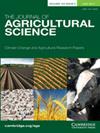White Lupin as a New Crop for Plant Proteins
IF 1.7
4区 农林科学
Q2 AGRICULTURE, MULTIDISCIPLINARY
引用次数: 0
Abstract
The world is demanding more protein for human consumption-increasing amounts of plant proteins are being used to meet this increasing demand. It has been estimated that global plant-based alternative protein market could swell to $162 billion in the next decade from $29.4 billion in 2020 and every tenth portion of meat, eggs, and dairy eaten around the globe by 2035 could be derived from plant proteins. White lupin (Lupinus albus L.), a legume, has been researched in Virginia for several years which has resulted in development of several winter-hardy and high yielding lines. However, concentrations of protein and relative concentrations of various amino acids in seeds of these lines are not known. Therefore, objective of this study was to characterize protein in winter-hardy lupin lines. Seeds of five winter-hardy white lupin lines grown during 2020-2021 contained about 51% protein as compared to literature values of about 35 and 24% protein in soybean and winter pea seeds, respectively. Concentrations of nine essential amino acids (isoleucine, leucine, lysine, methionine, threonine, tryptophan, valine, phenylalanine, and histidine) in lupin seed varied from 1.25 to 1.41, 1.98 to 2.51, 1.12 to 1.60, 0.21 to 0.27, 1.03 to 1.28, 0.25 to 0.30, 1.22 to 1.40, 1.14 to 1.28, and 0.69 to 0.79, respectively. These concentrations compared quite well with those in soybean and winter pea seed. These results indicate that white lupin has considerable potential to meet alternative plant protein needs of manufactures and consumers.白露苹作为植物蛋白新作物
世界需要更多的蛋白质供人类食用——越来越多的植物蛋白被用来满足这一日益增长的需求。据估计,未来十年,全球植物性替代蛋白市场将从2020年的294亿美元扩大到1620亿美元,到2035年,全球食用的肉类、鸡蛋和乳制品中有十分之一可能来自植物蛋白。白露平(Lupinus albus L.)是一种豆科植物,在美国弗吉尼亚州进行了多年的研究,培育出了几个耐寒高产品系。然而,这些系种子中蛋白质的浓度和各种氨基酸的相对浓度尚不清楚。因此,本研究的目的是对耐冬油菜品系的蛋白质进行鉴定。2020-2021年期间生长的5个耐寒白豆品系的种子蛋白质含量约为51%,而大豆和冬豆种子的蛋白质含量分别约为35%和24%。罗苹种子中9种必需氨基酸(异亮氨酸、亮氨酸、赖氨酸、蛋氨酸、苏氨酸、色氨酸、缬氨酸、苯丙氨酸和组氨酸)的含量分别为1.25 ~ 1.41、1.98 ~ 2.51、1.12 ~ 1.60、0.21 ~ 0.27、1.03 ~ 1.28、0.25 ~ 0.30、1.22 ~ 1.40、1.14 ~ 1.28和0.69 ~ 0.79。这些浓度与大豆和冬豆种子中的浓度相当。这些结果表明,白露平具有相当大的潜力来满足制造商和消费者对替代植物蛋白的需求。
本文章由计算机程序翻译,如有差异,请以英文原文为准。
求助全文
约1分钟内获得全文
求助全文
来源期刊

Journal of Agricultural Science
农林科学-农业综合
CiteScore
2.80
自引率
5.00%
发文量
68
审稿时长
1.4 months
期刊介绍:
The Journal of Agricultural Science publishes papers concerned with the advance of agriculture and the use of land resources throughout the world. It publishes original scientific work related to strategic and applied studies in all aspects of agricultural science and exploited species, as well as reviews of scientific topics of current agricultural relevance. Specific topics of interest include (but are not confined to): all aspects of crop and animal physiology, modelling of crop and animal systems, the scientific underpinning of agronomy and husbandry, animal welfare and behaviour, soil science, plant and animal product quality, plant and animal nutrition, engineering solutions, decision support systems, land use, environmental impacts of agriculture and forestry, impacts of climate change, rural biodiversity, experimental design and statistical analysis, and the application of new analytical and study methods (including genetic diversity and molecular biology approaches). The journal also publishes book reviews and letters. Occasional themed issues are published which have recently included centenary reviews, wheat papers and modelling animal systems.
 求助内容:
求助内容: 应助结果提醒方式:
应助结果提醒方式:


